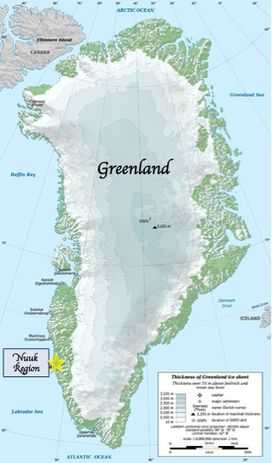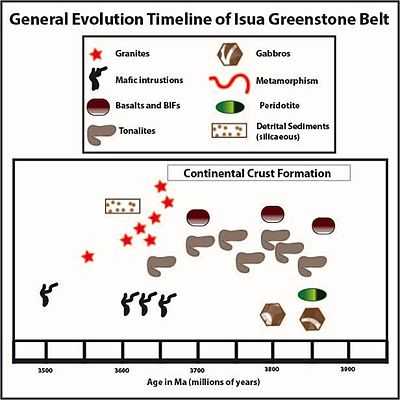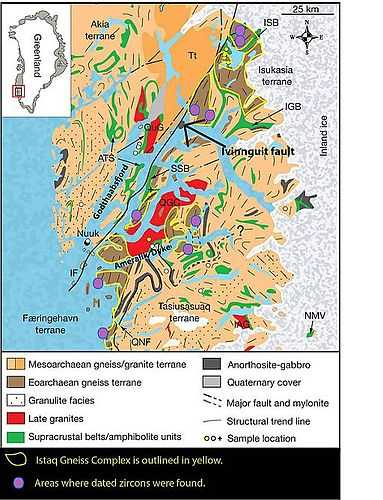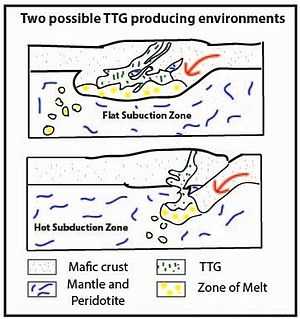Isua Greenstone Belt
| Isua Greenstone Belt | |
|---|---|
|
<div style="padding:2px 2px 5px 2px;>  The general location of the Isua Greenstone belt | |
| Highest point | |
| Elevation | 16 ft (5 m) |
| Dimensions | |
| Length | 35[1] km (22 mi) |
| Area | 3000 km2 |
| Countries | Greenland |
| Geology | |
| Orogeny | 300 million years to form |
| Period | Archean |
| Type of rock | Tonalites, mafic rocks, metasedimentary rocks, banded iron formations, granite, granodiorites |
The Isua Greenstone Belt is an Archean greenstone belt in southwestern Greenland. The belt is aged between 3.7 and 3.8 Ga, making it the home of the oldest rock in the world.[2] The belt contains variably metamorphosed mafic volcanic and sedimentary rocks. The occurrence of boninitic geochemical signatures offers evidence that plate tectonic processes may have been responsible for the creation of the belt.[1] However, this has recently been disputed by earth scientists who offer up a new theory for the formation of the Isua Greenstone Belt.[3] This new model is known as vertical plate tectonics and will be discussed further in the page.
Overview
The Isua Greenstone Belt, also known as the Isua supracrustal belt, is located in the Southwestern portion of Greenland, in the Isukasia terrane,[1] near the Nuuk region.[4] The greenstone belt is made up of metamorphosed mafic volcanic and sedimentary rocks that are usually juxtaposed by mylonites or fault boundaries. By using Uranium-lead dating on zircon and titanite, the tectonic history was dated to be approximately 3700-3600 million years old. It has been studied by earth scientists because of the evidence the area holds for early earth plate tectonics, as well as the fact that the area houses one of the oldest, best-preserved ancient plate tectonic sequences on earth.[5] In addition, the area is large, exposed, and there are areas that have experienced relatively low deformation and alteration to the original rock sequences.[2] The northern area of the Isua Greenstone Belt is mainly composed of amphibolite rocks, volcanic rocks, upper mantle peridotite, and layered gabbros; a suite which suggests crustal shortening.[2] Scientists have used different methods in order to determine how the Isua Greenstone Belt formed, some concluding that it formed at an ancient ocean-ocean convergent zone, where subduction caused partial melting and metasomatism of the mantle as well as the intrusion of tonalites partially melted the overlying supracrustal rocks and created the first continental crust. However, this area still remains under controversy in the scientific community, as scientists try to come to a consensus on how the Isua Greenstone Belt formed: whether due to a subduction zone or to some other process like vertical plate tectonics. Ultimately, a specific conclusion of how the Isua Greenstone Belt formed has not been reached, but some pieces of the puzzle have been proposed.
Scientific methods
In an attempt to understand the origin of the Isua Greenstone Belt, scientists have used several different methods. These include U-Pb zircon dating using SHRIMP, elemental chemistry and composition, stereonets, and lithologic association.[2] In addition to information gathered directly from the rocks, scientists have also used observations of the placement of the rocks and how they are separated into units: this is a more kinematic approach to the area. In addition, zoned garnets from different areas of the Isua Greenstone Belt have been used in garnet-biotite geothermometry, which has been used to determine the timing of metamorphism.[5] Scientists have tried to relate their findings to modern day proxies of subduction zones and tectonic events.
Lithologies
Efforts to depict initial lithologies and tectonic formation of the Isua Belt have been difficult due to the immense episodes of regional metamorphism the area has experienced,[7] which is why most efforts have been focused on the northern complex, called the Isukasia Terrane,[2] where the area exhibits a lower metamorphic grade.[2] There are several lithologies that make up the Isua Greenstone Belt and the main rock types have been located and mapped. These include the Amitsoq TTG orthogneisses, pillow lavas and pillow breccias, banded iron formations, granodiorites, and metasedimentary rocks. In addition, the area contains other, less prevalent, lithologies such as meta-chert, and mafic volcanic rocks.[8] Although there is still some debate on the kinematics of how each rock type was formed and became a part of the Isua Supracrustal belt, these rock types are clues to the formation of the greenstone belt and have been extensively mapped. The first image on the right is a map view of the entire greenstone belt area, with rock types and locations, found on the southwestern portion of Greenland. Additionally, the second image is a general timeline that shows when each rock was intruded into the greenstone belt.[2]
- These rocks were most likely formed from the underplate melting of oceanic crust.
- The protoliths of these rocks were most likely a basalt, komatiite, and chert assemblage, or tonalite.[10]
- The major deformation event that created the gneiss from tonalite occurred before diorite inclusions, at a time between 3.698 and 3.659 billion years ago.[11]
- The chemistry of the tonalite-trondhjemite-granodiorite (TTG) show significant indication of being derived from a mix of old crust and younger mantle sources, the product of a hydrated basaltic slab being subducted and then mixed with components of the mantle.[7] After these were melted, they intruded into the overlying basaltic crust.[10]

- 2) Pillow lavas and pillow breccias:
- The presence of these rocks indicate that there was liquid water available at the time of formation.
- The pillow lavas are the largest stratigraphic unit in the area (at approximately 6 km2 and they make up the central portion of the Isua Greenstone Belt.[8] They were tested to see how Ba/La (barium and lanthanum) and Ba/Nb (barium and niobium) isotopes trended when plotted against each other. The samples had very similar results to that of modern basalts. This indicated that there was most likely a sediment cover on the subducting oceanic crust in the Archean.[12]
- In some areas, mainly in the northern area, the pillow basalts have been completely altered into garbenschiefer amphibolite.[8] However there is some debate on whether it was formed from an intrusion or a volcanic sediment pile[8]
- The pillow breccias found in the Isua Greenstone Belt are interesting in part because of the particular quartz inclusions found in them. there are quartz crystals found that are unstrained, formed before metamorphism and contain fluid inclusions. The fluid inclusions came from two main sources: pure methane and a high saline aqueous fluid. This is further evidence to support that the pillow breccias came from a sea-floor hydrothermal system, approximately 3.75 billion years ago.[8]
- 3) Banded Iron Formations:
- Interlayered iron and chert are the most common sedimentary rock found in the Isua Greenstone Belt.[13]
- The BIFs in this area offer a relationship between the rocks and seafloor hydrothermal alteration.[14]
- The banded iron formations found contain REEs (rare earth elements) and positive europium and or negative cerium anomalies. This pattern is coincident with the chemical precipitation of solutions that contained seawater and iron (Fe), an input that most likely came from diverging oceanic plates.[14]
- 4) Peridotites:
- Specifically abyssal peridotites were thought to have been found.
- These are usually found deep within oceanic crust and are brought to the surface of the earth through obduction.
- One of the major arguments of scientists for a subduction environment is the presence of an ophiolite sequence.[2]
Tectonics
The Isua Greenstone Belt offers up some complications because of the tectonics that have occurred in the area. Subduction and plate tectonics overall, is a means for explaining heat transfer within the earth, which was an important process in early earth.[3] The Isua Greenstone Belt is also an important area on the globe because it in particular contains the only evidence on the earth that holds record for deformation before 3.2 billion years ago.[3]
Some scientists have observed geometric patterns in the area and have attributed it to a certain type of tectonic event called a thrust nappe.[15] The klippe is the isolated block of the nappe overlying autochthonous material. This geologic formation is evidence of thrusting plate motion, towards the south in this particular region.[15] A thrust suggests that this area did experience subduction in the Archean.[15] The implications of this come from studies of the deformational behavior, rheology, and strength of the Archean crust, all of which has been proposed to be very similar to the current crust.[15]
Metamorphism
Evidence from zoned garnets can give insight into the metamorphic history of an area.[5] What one scientist found was that there were three main episodes of garnet growth in the Isua Greenstone Belt, meaning there were three main metamorphic events.[5] Specifically, the garnets were studied in terms of overgrowth patterns using iron-magnesium rich rim, manganese rich cores, then by a calcium-rich rims and cores. In addition, the presence of these overgrowths and their oscillatory zoned nature leads scientists to believe that the metamorphism occurred due to fluid-like metasomatism. Manganese is suggestive of prograde metamorphism.[5] Overall it has been suggested that there were three metamorphic events, occurring 3.74 billion years ago, 3.69 billion years ago, and at 2.8 billion years ago.
Results of several studies
The following table is shown to condense the efforts of many scientists and the evidence that they found, as well as their idea of what it could mean for the formation of early Archean continental crust.
| What was found | What it could mean | Why |
|---|---|---|
| The presence of peridotite, which is usually found in ophiolite sequences | This indicates horizontal movement of plates [3] | Ophiolite sequences have to be obducted onto continental crust in order to be observed |
| The enrichment of LREE and depletion of Ti and Nb in mafic amphibolites found in the Istaq Gneiss Complex [2] | The rocks were derived from arc-related basalts [2] | Using subduction zone proxy of modern day plate tectonics, LREEs come from a depleted mantle |
| Tonalites contain minorquartz-diorites which have high Mg (magnesium) contents | Some mantle melt was included within the derivation of rocks[2] | Current day proxies with plate tectonics also contain high magnesium quartz-diorites |
| Zircons were found that formed at temperatures of >900 °C [2] | Must have formed from an original source and not from the surrounding country rock | Zircons would have been melted had they come from the country, or preexisting, rock |
| Hafnium isotope evidence shows crustal reworking over 3.2 billion years ago[6] | There was a crustal evolutionary period between about 3.9-3.5 billion years ago, which then led a transition period, eventually leading to a modern day style plate tectonics at approximately 3.2 billion years ago[6] | This is evidence of reworking and changing of protolith |
If you notice, a lot of this evidence has been used to describe modern day plate tectonics. A problem with this is that Archean plate tectonics could have been vastly different than the processes that are occurring on earth today.
Proposed origin of continental crust
The easiest way to think about the Isua Greenstone Belt is in two parts: a north and a south which are broken up by a fault. The northern terrane is dominated by tonalites and is the least metamorphosed section.[16] It also contains zircon ages of approximately 3710-3690 million years old. The southern portion of the Isua Greenstone Belt contains approximately 3900-3810 million year old zircons with an abundance of amphibolite, schist, carbonate rock, volcanics, pillow lavas, and ultramafics.[8] The northern portion makes up the area where many scientific studies have been conducted and offers up the evidence leading scientist to propose the following hypothesis.
Formation of the Isua Greenstone Belt
The origin of continental crust which formed the greenstone belt, was reconstructed using geochemical, lithological, and structural clues.[17] All of this information is coincident with the idea that:
The reworked crust can be attributed to the burial, most likely through subduction, of those hydrated materials, such as basalt, which were formed in the Hadean.[18] Additionally, the source for tested rock samples came from a depleted mantle. The presence of a depletion in titanium and niobium, as well as an enrichment in lead, strontium, barium, rubidium, and light rare earth elements, indicates arc-related basalts.[2] The diorites found in the area are high in magnesium and REE (rare earth elements), which suggest further that the rocks were formed from a mixture of the mantle and melted basaltic crust.[7] Overall, the presence of tonalite-trondhjemite-granodiorites, as well as the iron present for the BIFs, are determined to have been caused by high temperature hydrothermal alteration.[17] Banded iron formations are typically found in intra-oceanic, arc or forearc settings, which are associated with convergent boundaries. The intrusions were formed when upwelling asthenosphere partially melted thick overlying oceanic crust.[17] It is thought that the melting and reworking of oceanic crust formed the early Archean continental crust. In addition, the eclogite residues, formed by the partial melting of the oceanic crust, became a part of the sub-continental lithospheric mantle. By using uranium-lead dating on zircons, scientists were able to determine that the process of creating the Isua Greenstone Belt took approximately 300 million years.[2]
Many pieces of evidence are thought to support the theory that the formation of continental crust must have started with the subduction of hot, oceanic crust. This subducting slab melted and this in combination with asthenospheric upwelling partially melted the oceanic crust above. The result of testing and putting together information has led scientists to believe that crustal growth began approximately 3.8 billion years ago.[2] and continued building slowly, in short time increments. Then, stabilization of crust occurred quickly, about 2.975 billion years ago.[14] The image to left is a schematic that shows two possible flat subduction mechanisms that could create the tonalite plutons seen in the greenstone belt.[2] However, this method of crustal formation is just one theory and has been questioned by many scientists.
Controversies
In the scientific community, studies are still being conducted that hope to solve the big question of the Isua Greenstone Belt: What processes caused its formation? This area remains under controversy in the scientific community because it is arguable that there were different tectonic processes, or styles, occurring in Archean times that would have affected the outcome of what we see today: a mass of very old rocks surrounded by younger rocks that have been heavily altered in some areas and are separated by tectonic and depositional contacts.[2] The Isua Greenstone Belt is the only place on the world that does not conform entirely to the idea of vertical plate tectonics (an idea that is still debated). Some problems that occur within the area are as follows:
- The availability of zircons to be dated are few.
- The effect of deformation in the area has destroyed some important information.[2]
- The isotopic chemistry is known, but is only attributed to current day proxies, which may have been different in the Archean.
- Very little preserved mafic crust from the Archean.[2]
Alternative hypothesis
Vertical plate tectonics
There is an alternate idea that early earth plate tectonics began by vertical movement of the lithosphere, rather than the modern horizontal tectonics. This theory suggests that crust was formed through tectonic stacking of oceanic lithosphere above a subduction zone, which formed a conical shaped feature: the middle of the cone being depressed.[19]
Similar evidence
The Isua Greenstone Belt is an anomaly in terms of the other greenstone belts in the world. It is the only greenstone belt that has preserved deformational events from greater than 3.2 Ga[2] and contains peridotites (indicating an obducted ophiolite sequence). However, as compared to the Pilbara Craton and the Barberton Greenstone Belts, which have alternate evolution theories, there are a few similarities.[3]
- The greenstone belts took a period of about 300 million years to form.
- They contain similar protoliths.[3]
- Each went through cycles of deformation.
- They all contain TTG sequences.
- These TTGs represent similar temperature and pressure conditions of formation (either 1.5 or 3.0 GPa and between 1000 °C and 1200 °C).[3]
- Contain evidence of low pressure and high temperature generation of tonalite plutons.
Evidence for both situations
| Subduction Zone | Vertical Plate Tectonics |
|---|---|
| The presence of peridotite (which is related to ophiolite sequences) indicates horizontal movement of plates [3] | Studies have shown that Archean TTGs are formed primarily through melting of the host rock, meaning it does not indicate subduction-related arc magmatism.[19] |
| > 3.2 Ga deformation event | Similar protoliths as the Pilbara Craton and Barberton Craton |
| Garnet growths suggest fluid-related metasomatism [5] | Low geothermal gradients and low pressure conditions are representative of downward advection in the mantle [3] |
| Depletions in titanium and niobium and enrichments in lead, strontium, barium, and light rare earth elements suggest arc-related basalts | A decrease in the crustal growth rate approximately 3.2 Ga ago. This would indicate a time when plate tectonics (along with the crustal balance with subduction and convergence) actually began.[3] |
See also
References
- ↑ 1.0 1.1 1.2 Bennett, Vickie C.; Nutman, Allen P. (April 2014). "Isua Supracrustal Belt, West Greenland: Geochronology". Encyclopedia of Scientific Dating Methods: 1–4. doi:10.1007/978-94-007-6326-5_109-1.
- ↑ 2.0 2.1 2.2 2.3 2.4 2.5 2.6 2.7 2.8 2.9 2.10 2.11 2.12 2.13 2.14 2.15 2.16 2.17 2.18 2.19 2.20 2.21 2.22 Nutman, Allen P.; Friend, Clark R.L.; Horie, Kenji; Hidaka, Hiroshi (2007). "The Itsaq Gneiss Complex of Southern West Greenland and the Construction of Eorarchean Crust at Convergent Plate Boundaries". Developments in Precambrian Geology 15: 187–218. doi:10.1016/S0166-2635(07)15033-7.
- ↑ 3.0 3.1 3.2 3.3 3.4 3.5 3.6 3.7 3.8 3.9 Moore, William B.; Webb, Alexander G. (26 September 2013). "Heat-pipe Earth". Nature 501 (505).
- ↑ Bennett, Vickie C.; Nutman, Allen P. (2014). Isua Supracrustal Belt, West Greenland: Geochronology. Australia. p. 1. ISBN 978-94-007-6326-5.
- ↑ 5.0 5.1 5.2 5.3 5.4 5.5 Rollinson, Hugh (5 February 2003). "Metamorphic history suggested by garnet-growth chronologies in the Isua Greenstone Belt, West Greenland". Elsevier 126: 181–196. doi:10.1016/s0301-9268(03)00094-9.
- ↑ 6.0 6.1 6.2 Naerra, T.; Schersten, A.; Rosing, M. T.; Kemp, A. I. S.; Hoffman, J. E.; Kokfelt, T.F.; Whitehouse, M. J. (May 2012). "Hafnium isotope evidence for a transition in the dynamics of continental growth 3.2 Gyr ago". Nature 485 (7400): 627–630. doi:10.1038/nature11140.
- ↑ 7.0 7.1 7.2 Hugh, Rollinson. "TTG Genesis and Archaean Crustal Growth". GEMRU.
- ↑ 8.0 8.1 8.2 8.3 8.4 8.5 Appel, Peter W.; Rollinson, Hugh R.; Touret, Jacques L.R. (15 November 2001). "Remnants of an Early Archean (>3.75 Ga) sea-floor hydrothermal system in the Isua Greenstone Belt". Precambrian Research 112 (1-2): 27–49. doi:10.1016/s0301-9268(01)00169-3.
- ↑ Museum of Evolving Earth. "Geology of the Isua supracrustal belt". Tokyo Institute of Technology.
- ↑ 10.0 10.1 Rollinson, Hugh (1999). "TTG Genesis and Archaean Crustal Growth". Journal of Conference Abstracts 4 (1).
- ↑ Crowley, J.L; Myers, J.S.; Dunning, G.R. "Timing and nature of multiple 3700-3600 Ma tectonic events in intrusive rocks north of the Isua greenstone belt, souther West Greenland" 114 (10). pp. 1311–1325.
- ↑ Jenner, F.E; Bennett, Vickie E.; Friend, Allen P.; Clark, R.L.; Norman, M.D.; Yaxley, G. (15 April 2009). [Series: http://www.sciencedirect.com.libezp.lib.lsu.edu/science/journal/00092541 "Evidence for subduction at 3.8 Ga; geochemistry of arc-like metabasalts from the southern edge of the Isua supracrustal belt"]. Chemical Geology 261 (1-2): 82–97. doi:10.1016/j.chemgeo.2008.09.016.
- ↑ Fedo, Christopher M.; Myers, John S.; Appel, Peter W. (June 2001). "Depositional setting and paleogeogeographic implications of eart's oldest supracrustal rocks, the >3.7 Ga Isua Greenstone belt, West Greenalnd". Science Direct. 141-142: 61–77. doi:10.1016/s0037-0738(01)00068-9.
- ↑ 14.0 14.1 14.2 Polat, Ali; Frei, Robert (20 April 2005). "The origin of early Archean banded iron formations and of continental crust, Isua, southern West Greenland". Science Direct 138.
- ↑ 15.0 15.1 15.2 15.3 Hanmer, Simon; Greene, David C. (20 April 2000). "A modern structural regime in the Paleoarchean (f3.64 Ga); Isua Greenstone Belt, southern West Greenland". Tectonophysics 346: 201–222.
- ↑ Nutman, Allen P.; Friend, Clark R.L.; Paxton, Shane (August 2009). "Detrital zircon sedimentary provenance ages for the Eoarchaean Isua supracrustal belt southern West Greenland; juxtaposition of an imbricated ca. 3700 Ma juvenile arc against an older complex with 3920-3760 Ma components". Precambrian Research 172 (3-4): 212–233. doi:10.1016/j.precamres.2009.03.019.
- ↑ 17.0 17.1 17.2 Polat, Ali; Frei, Robert (20 April 2005). "The origin of early Archean banded iron formations and of continental crust, Isua, south Western Greenland". Science Direct. Precambrian Research (138): 151–157.
- ↑ van Kranendonk, Martin J.; Smithies, Hugh R.H.; Bennett, Vickie (26 October 2007). Earth's Oldest Rocks. Amsterdam, The Netherlands: Elsevier. ISBN 978-0-444-52810-0.
- ↑ 19.0 19.1 Van Kranendonk, Martin J. (2011). "Cool greenstone drips and the role of partial convective overturn in Barberton greenstone belt evolution". Journal of African Earth Sciences 60: 346–352. doi:10.1016/j.jafrearsci.2011.03.012.

